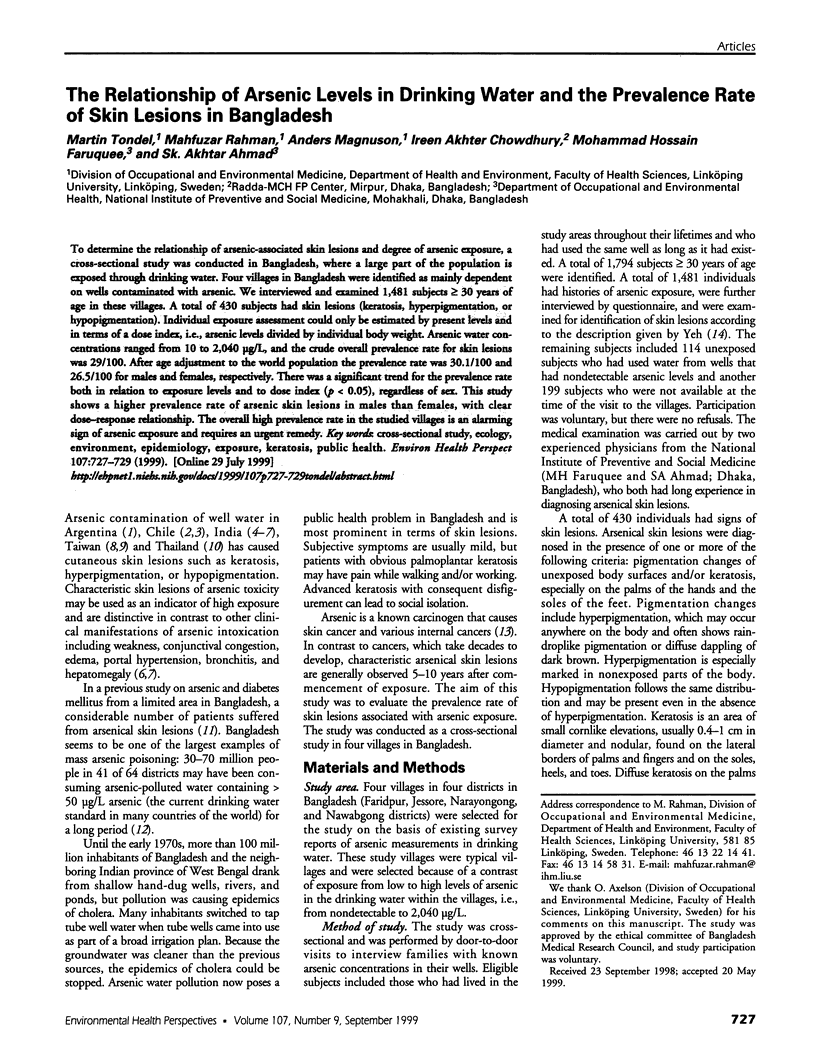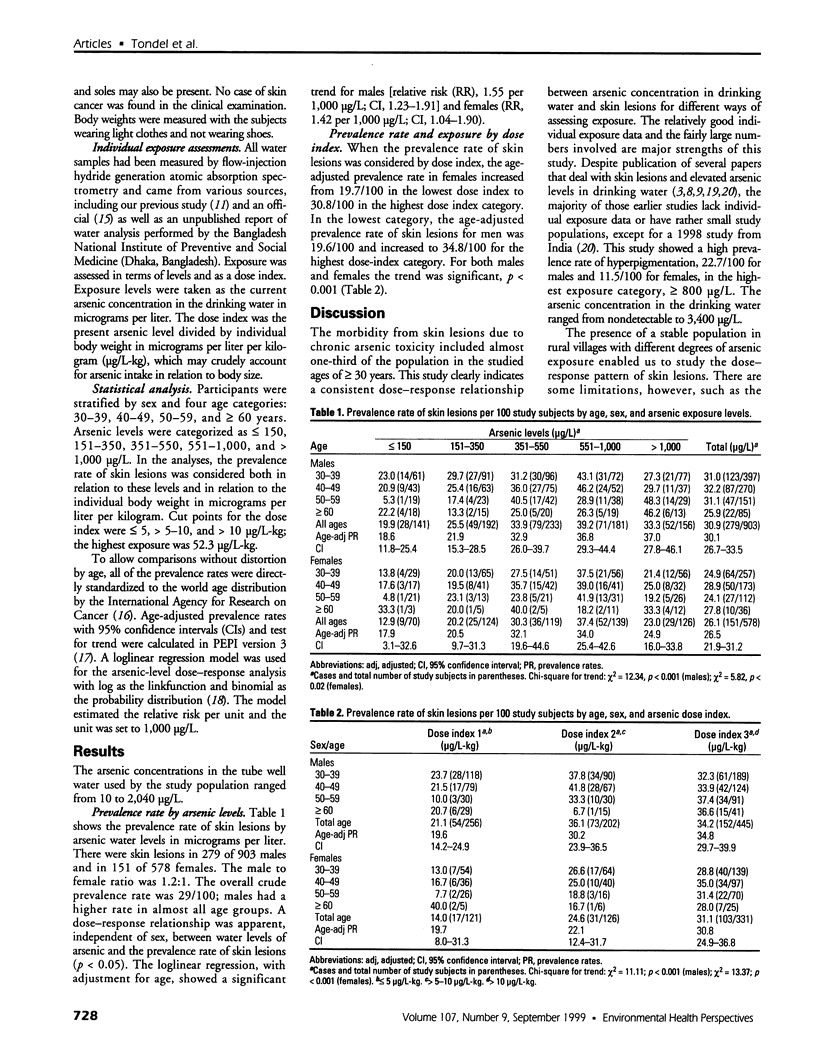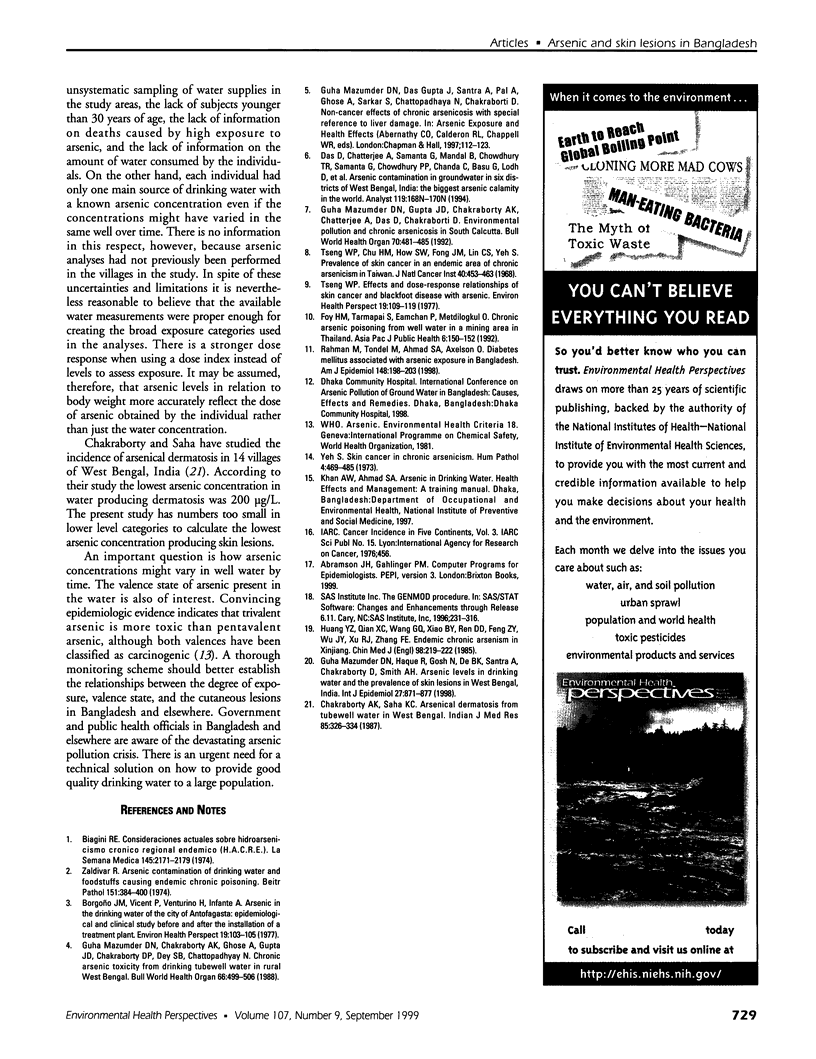Abstract
To determine the relationship of arsenic-associated skin lesions and degree of arsenic exposure, a cross-sectional study was conducted in Bangladesh, where a large part of the population is exposed through drinking water. Four villages in Bangladesh were identified as mainly dependent on wells contaminated with arsenic. We interviewed and examined 1,481 subjects [Greater/equal to] 30 years of age in these villages. A total of 430 subjects had skin lesions (keratosis, hyperpigmentation, or hypopigmentation). Individual exposure assessment could only be estimated by present levels and in terms of a dose index, i.e., arsenic levels divided by individual body weight. Arsenic water concentrations ranged from 10 to 2,040 microg/L, and the crude overall prevalence rate for skin lesions was 29/100. After age adjustment to the world population the prevalence rate was 30. 1/100 and 26.5/100 for males and females, respectively. There was a significant trend for the prevalence rate both in relation to exposure levels and to dose index (p < 0.05), regardless of sex. This study shows a higher prevalence rate of arsenic skin lesions in males than females, with clear dose-response relationship. The overall high prevalence rate in the studied villages is an alarming sign of arsenic exposure and requires an urgent remedy.
Full text
PDF


Selected References
These references are in PubMed. This may not be the complete list of references from this article.
- Borgoño J. M., Vicent P., Venturino H., Infante A. Arsenic in the drinking water of the city of Antofagasta: epidemiological and clinical study before and after the installation of a treatment plant. Environ Health Perspect. 1977 Aug;19:103–105. doi: 10.1289/ehp.19-1637404. [DOI] [PMC free article] [PubMed] [Google Scholar]
- Chakraborty A. K., Saha K. C. Arsenical dermatosis from tubewell water in West Bengal. Indian J Med Res. 1987 Mar;85:326–334. [PubMed] [Google Scholar]
- Das D., Chatterjee A., Samanta G., Mandal B., Chowdhury T. R., Samanta G., Chowdhury P. P., Chanda C., Basu G., Lodh D. Arsenic contamination in groundwater in six districts of West Bengal, India: the biggest arsenic calamity in the world. Analyst. 1994 Dec;119(12):168N–170N. doi: 10.1039/an994190168n. [DOI] [PubMed] [Google Scholar]
- Foy H. M., Tarmapai S., Eamchan P., Metdilogkul O. Chronic arsenic poisoning from well water in a mining area in Thailand. Asia Pac J Public Health. 1992;6(3):150–152. doi: 10.1177/101053959200600306. [DOI] [PubMed] [Google Scholar]
- Guha Mazumder D. N., Chakraborty A. K., Ghose A., Gupta J. D., Chakraborty D. P., Dey S. B., Chattopadhyay N. Chronic arsenic toxicity from drinking tubewell water in rural West Bengal. Bull World Health Organ. 1988;66(4):499–506. [PMC free article] [PubMed] [Google Scholar]
- Guha Mazumder D. N., Haque R., Ghosh N., De B. K., Santra A., Chakraborty D., Smith A. H. Arsenic levels in drinking water and the prevalence of skin lesions in West Bengal, India. Int J Epidemiol. 1998 Oct;27(5):871–877. doi: 10.1093/ije/27.5.871. [DOI] [PubMed] [Google Scholar]
- Huang Y. Z., Qian X. C., Wang G. Q., Xiao B. Y., Ren D. D., Feng Z. Y., Wu J. Y., Xu R. J., Zhang F. E. Endemic chronic arsenism in Xinjiang. Chin Med J (Engl) 1985 Mar;98(3):219–222. [PubMed] [Google Scholar]
- Mazumder D. N., Das Gupta J., Chakraborty A. K., Chatterjee A., Das D., Chakraborti D. Environmental pollution and chronic arsenicosis in south Calcutta. Bull World Health Organ. 1992;70(4):481–485. [PMC free article] [PubMed] [Google Scholar]
- Rahman M., Tondel M., Ahmad S. A., Axelson O. Diabetes mellitus associated with arsenic exposure in Bangladesh. Am J Epidemiol. 1998 Jul 15;148(2):198–203. doi: 10.1093/oxfordjournals.aje.a009624. [DOI] [PubMed] [Google Scholar]
- Tseng W. P., Chu H. M., How S. W., Fong J. M., Lin C. S., Yeh S. Prevalence of skin cancer in an endemic area of chronic arsenicism in Taiwan. J Natl Cancer Inst. 1968 Mar;40(3):453–463. [PubMed] [Google Scholar]
- Tseng W. P. Effects and dose--response relationships of skin cancer and blackfoot disease with arsenic. Environ Health Perspect. 1977 Aug;19:109–119. doi: 10.1289/ehp.7719109. [DOI] [PMC free article] [PubMed] [Google Scholar]
- Yeh S. Skin cancer in chronic arsenicism. Hum Pathol. 1973 Dec;4(4):469–485. doi: 10.1016/s0046-8177(73)80060-7. [DOI] [PubMed] [Google Scholar]
- Zaldívar R. Arsenic contamination of drinking water and foodstuffs causing endemic chronic poisoning. Beitr Pathol. 1974 Apr;151(4):384–400. doi: 10.1016/s0005-8165(74)80047-8. [DOI] [PubMed] [Google Scholar]


